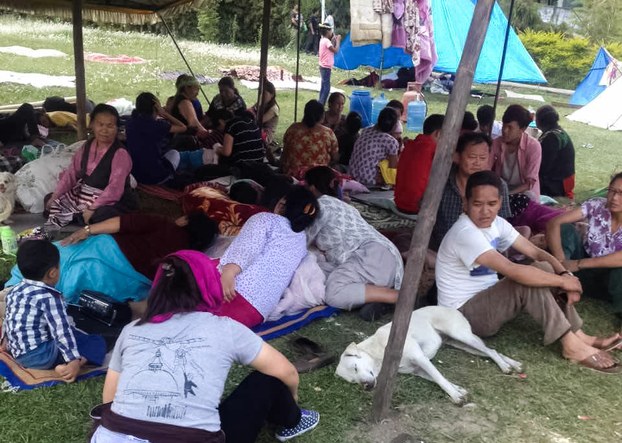Tibetans in Nepal take stock of damage following quake
| Publisher | Radio Free Asia |
| Publication Date | 29 April 2015 |
| Cite as | Radio Free Asia, Tibetans in Nepal take stock of damage following quake, 29 April 2015, available at: https://www.refworld.org/docid/555edb4815.html [accessed 21 May 2023] |
| Disclaimer | This is not a UNHCR publication. UNHCR is not responsible for, nor does it necessarily endorse, its content. Any views expressed are solely those of the author or publisher and do not necessarily reflect those of UNHCR, the United Nations or its Member States. |
2015-04-29
 Tibetan survivors of Nepal earthquake shelter under a tent in Kathmandu, April 29, 2015. Thubten
Tibetan survivors of Nepal earthquake shelter under a tent in Kathmandu, April 29, 2015. Thubten
Tibetan residents of Nepal's capital Kathmandu met on Wednesday to consider how to provide assistance to Tibetans affected by a devastating earthquake that rocked the country on Saturday, killing more than 5,000 and leaving remote areas cut off from help.
Major structural damage to Tibetan monasteries, homes, and schools has now been reported in the capital, with greater destruction believed to have occurred in the mountainous region bordering Tibet, sources said.
"I think we should ask Nepal's government for a helicopter to take food and clothing from here, as walking to those places would not be possible," said one participant in the April 29 meeting, convened by the Tibetan Refugee Welfare Office based in Nepal.
"The monasteries in Kathmandu have organized relief work and have already dispatched teams to the affected local areas," the man, named Ngawang Yonten, told RFA.
"The monasteries have already started giving out free food to people who are sleeping outdoors for fear of further earthquakes."
"It is also very important for us to help the Nepalese government in its own relief efforts," Yonten said.
Schools, monasteries damaged
Kathmandu-area Tibetan schools and monasteries including Shechen, Kopan, and Rinchen Ling, though spared total destruction, were badly damaged in the quake, said meeting participant Dzamling Wangdu.
A multistoried former factory building used as a residence for Tibetan families in the Bodhanath area was "severely" damaged, though, Wangdu said.
"This building accommodates 170 residents belonging to about 37 families," Wangdu said.
"We must assess the safety of this building and determine whether it will still be safe to live there. It needs repair, and the local residents are not in a position to do this, so we need help from abroad and from other local Tibetans," he said.
"Many Tibetans panicked when the earthquake struck," Thubten, a Tibetan living in Nepal, said. "Some were injured when they tried to escape by jumping out of windows."
In Tibetan-populated areas of Kathmandu, Pokhara, Namche, and Solokhumbu, houses collapsed or sustained cracks, Thubten said, adding that four Tibetans, including a nun, are now confirmed to have died.
"But we expect more fatalities and injuries because Tibetans are spread over 13 of Nepal's 75 districts. We still don't know what happened to Tibetans living in far-flung areas," he said.
"Only 10 percent of the Tibetan merchants in Nepal own their own houses," Thubten said. "The rest live in rental properties."
"After the earthquake, many of the houses became too dangerous to live in. So they set up tents in schools and temples. They need food and water. Government help has been slow in coming. They are in dire straits."
Efforts to help
Tibetan residents of Kathmandu have now launched a campaign to clean the outdoor areas where people are camping for safety, with members of the Tibetan Youth Congress activist group delivering food to injured patients in hospitals and Buddhist monks helping search for victims still trapped in the rubble, sources said.
In the mountainous and now-inaccessible Dram region bordering Tibet, the monastery, nunnery, and retreat center of the prominent reincarnate lama Sengdrak Rinpoche meanwhile lie largely in ruins, a Tibetan monk told RFA this week.
"There are 210 nuns in the nunnery there, of whom one died and three were injured," the monk, Ngawang Chotrul Rinpoche, said.
"We heard that the monastery itself was completely destroyed, with the 25 to 30 monks who lived there now staying out in the open with no shelter," he said.
"We can't communicate with them now, and they are receiving no help either from Nepal or from Tibet," he said.
Reported by Thubten Sangyay, Lhuboom, Pema Ngodup, and Dawa Dolma for RFA's Tibetan Service and by Dan Zhen for the Mandarin Service. Translated by Karma Dorjee and by Jennifer Chou. Written in English by Richard Finney.
Link to original story on RFA website
